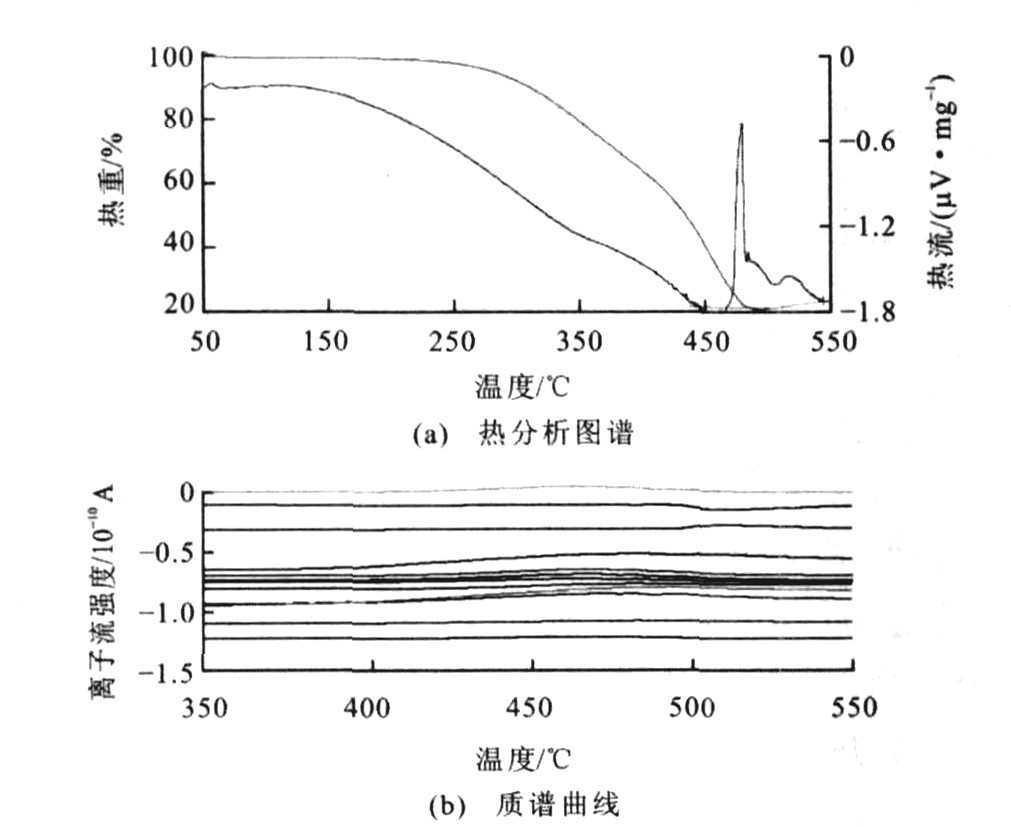Property analysis of Tahe road asphalt using simultaneous thermog-ravimetry-differential scanning calorimetry-mass spectrometry
-
摘要: 为深入分析沥青微观结构、热性质与沥青路用性能之间的关系, 采用热重-差热分析-质谱联用技术研究了3种塔河沥青在30℃~550℃范围内升温时的热重与吸热性质, 检测了沥青挥发与热分解的小分子产物, 并分析了微观结构与沥青路用性能的关系。研究结果表明: 挥发与热分解产物中质荷比为60以下的物质中主要有H2O、H2、C2H4(或CO)和OH基离子团, 塔河沥青热重曲线从240℃左右开始有明显的失重现象, 其宏观性能的改善, 在微观上表现为烃类分解放热量的增加和分解残留质量比的降低。Abstract: In order to investigate the relation among the microstructure, thermal property and road performance of asphalt, three asphalts refined from Tahe rude oil were studied by using simultaneous thermogravimetry-differential scanning calorimetry-mass spectrometry(TG-DSC-MS), the volatilizations, pyrolysis behaviors and thermal properties of three asphalts were studied from 30 ℃ to 550 ℃, and the relation between asphalt microstructure and road performance was analyzed. Analysis result indicates that asphalt productions in volatilization and thermal decomposition courses are mainly H2O、H2、C2H4(or CO)and ionic groupion(OH) when its mass-to-charge ratio is below 60, there is an obvious trend of weight loss from 240 ℃ in Tahe asphalt's thermogravimetric curve, and the improvement of asphalt performance is related to the increase of pyrolysis caloric and the decrease of residue mass.
-
Key words:
- pavement engineering /
- Tahe asphalt /
- road performance /
- simultaneous TG-DSC-MS
-
表 1 3种沥青基本性质
Table 1. Basic properties of three asphalts
项目 塔河90# 市政90# SBS改性 25 ℃针入度/0.1mm 79.7 77.1 79.3 15 ℃延度/cm 106.3 > 150.0 > 150.0 软化点/℃ 47.8 49.0 61.5 闪点/℃ 238 238 230 针入度指数PI -0.55 0.47 0.97 TFOT 质量变化/% -0.22 -0.36 -0.41 残留针入度比/% 63.5 66.0 72.7 10 ℃残留延度/cm 6.3 94.3 30.1* 注: 带“*”表示SBS改性沥青延度试验温度为5 ℃。 表 2 试样编号
Table 2. Serial numbers of samples
序号 试样 编号 1 塔河基质90# 1-1, 1-2 2 塔河市政专用90# 4-1, 4-2 3 塔河90#制备SBS 5-1, 5-2 表 3 参量设定
Table 3. Parameter settings
离子 质荷比 离子 质荷比 O或CH4 16 O2 32 OH 17 C3H7 43 H2O 18 C3H8或CO2 44 C2H3 27 H2 2 CO或C2H4 28 C4H6 42 C2H5 29 C4H8 56 C2H6 30 表 4 TG-DSC-MS试验结果
Table 4. TG-DSC-MS test result
试样编号 DSC放热/(μV·mg-1) DSC峰值温度/℃ TG质量变化/% 1-1 49.90 482.1 — -82.40 1-2 62.51 486.3 — -81.86 4-1 127.40 484.4 522.8 82.37 4-2 123.80 483.0 517.9 -82.82 5-1 162.50 487.3 544.5 -82.72 5-2 164.00 483.1 515.0 -83.11 -
[1] PUZI NAUSKAS V P. Properties of asphalt cements[J]. Association of Asphalt Paving Technologists, 1979, 48: 646-710. https://trid.trb.org/view/728223 [2] PETERSONJ C, ROBERSTON R E, BRANTHAVERJ F, et al. Binder characterization and evaluation volume4: test methods(SHRP A-370)[R]. Washington DC: National Research Council, 1994. [3] BRANTHAVERJ F, PETERSONJ C, ROBERTSON R E, et al. Binder characterization and evaluation volume2: chem-istry(SHRP A-368)[R]. Washington DC: National Research Council, 1993. [4] ANDERSON D A, CHRISTENSEN D W, BAHIA H. Physical properties of asphalt cement and the development of perform-ance-related specifications[J]. Association of Asphalt Paving Technologists, 1991, 60: 437-475. [5] HARRISONI R, WANG G, HSU T C. Adifferential scan-ning calori metry study of asphalt binders(SHRP-A/UFR-92-612)[R]. Washington DC: National Research Council, 1992. [6] KOTAE N, HUSAI N U B. Effect of binder and mixture variables on glass transition behavior of asphalt mixtures[J]. Association of Asphalt Paving Technologists, 2004, 73: 1-40. https://trid.trb.org/view/749989 [7] 董瑞琨, 孙立军. 考虑老化的沥青结合料低温感温性指标[J]. 中国公路学报, 2006, 19(4): 34-39. doi: 10.3321/j.issn:1001-7372.2006.04.007DONG Rui-kun, SUNLi-jun. Lowtemperature susceptibility indexes of asphalt binder with different aging degree[J]. China Journal of Highway and Transport, 2006, 19(4): 34-39. (in Chinese) doi: 10.3321/j.issn:1001-7372.2006.04.007 [8] 景彦平. 沥青组分划分方法[J]. 长安大学学报: 自然科学版, 2005, 25(3): 33-36. https://www.cnki.com.cn/Article/CJFDTOTAL-XAGL200503009.htmJI NG Yan-ping. Asphalt component methodology[J]. Jour-nal of Chang an University: Natural Science Edition, 2005, 25(3): 33-36. (in Chinese) https://www.cnki.com.cn/Article/CJFDTOTAL-XAGL200503009.htm [9] 张争奇, 张登良, 原健安. 用聚集态和分子量解释沥青的性能[J]. 西安公路交通大学学报, 1998, 18(S): 207-211. https://www.cnki.com.cn/Article/CJFDTOTAL-XAGL8S1.014.htmZHANG Zheng-qi, ZHANG Deng-liang, YUAN Jian-an. The influence of the molecular weight and the state transition charac-teristic on the performance of asphalt[J]. Journal of Xi an High-way University, 1998, 18(S): 207-211. (in Chinese) https://www.cnki.com.cn/Article/CJFDTOTAL-XAGL8S1.014.htm [10] 梁乃兴, 廉向东. 聚合物改沥青示差扫描量热(DSC)分析研究[J]. 西安公路交通大学学报, 2000, 20(3): 29-31. https://www.cnki.com.cn/Article/CJFDTOTAL-XAGL200003011.htmLI ANG Nai-xing, LI AN Xiang-dong. Study of polymer modified bitumen by DSC[J]. Journal of Xi an Highway University, 2000, 20(3): 29-31. (in Chinese) https://www.cnki.com.cn/Article/CJFDTOTAL-XAGL200003011.htm [11] 闫金定, 崔洪, 杨建丽, 等. 热重质谱联用研究兖州煤的热解行为[J]. 中国矿业大学学报, 2003, 32(3): 311-315. doi: 10.3321/j.issn:1000-1964.2003.03.023YANJin-ding, CUI Hong, YANGJian-li, et al. Research on pyrolysis behavior of Yanzhou coal using TG/MS[J]. Journal of China University of Mining and Technology, 2003, 32(3): 311-315. (in Chinese) doi: 10.3321/j.issn:1000-1964.2003.03.023 -





 下载:
下载:





